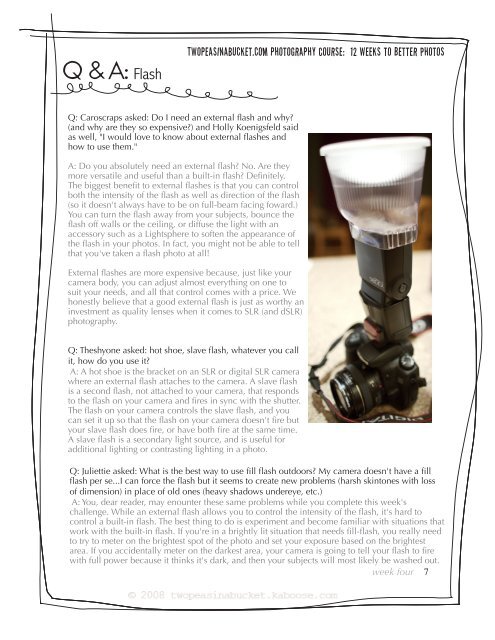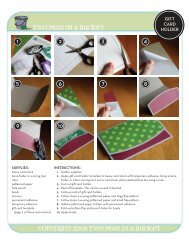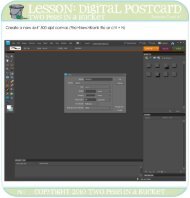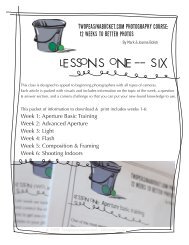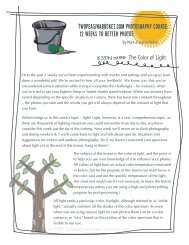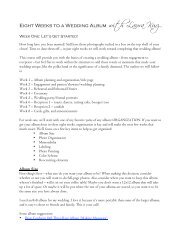TWOpeasinabucket.COM photography Course: 12 Weeks to Better ...
TWOpeasinabucket.COM photography Course: 12 Weeks to Better ...
TWOpeasinabucket.COM photography Course: 12 Weeks to Better ...
Create successful ePaper yourself
Turn your PDF publications into a flip-book with our unique Google optimized e-Paper software.
Q & A: Flash<strong>TWOpeasinabucket</strong>.com <strong>pho<strong>to</strong>graphy</strong> <strong>Course</strong>: <strong>12</strong> <strong>Weeks</strong> <strong>to</strong> <strong>Better</strong> Pho<strong>to</strong>sQ: Caroscraps asked: Do I need an external flash and why?(and why are they so expensive?) and Holly Koenigsfeld saidas well, "I would love <strong>to</strong> know about external flashes andhow <strong>to</strong> use them."A: Do you absolutely need an external flash? No. Are theymore versatile and useful than a built-in flash? Definitely.The biggest benefit <strong>to</strong> external flashes is that you can controlboth the intensity of the flash as well as direction of the flash(so it doesn't always have <strong>to</strong> be on full-beam facing foward.)You can turn the flash away from your subjects, bounce theflash off walls or the ceiling, or diffuse the light with anaccessory such as a Lightsphere <strong>to</strong> soften the appearance ofthe flash in your pho<strong>to</strong>s. In fact, you might not be able <strong>to</strong> tellthat you've taken a flash pho<strong>to</strong> at all!External flashes are more expensive because, just like yourcamera body, you can adjust almost everything on one <strong>to</strong>suit your needs, and all that control comes with a price. Wehonestly believe that a good external flash is just as worthy aninvestment as quality lenses when it comes <strong>to</strong> SLR (and dSLR)<strong>pho<strong>to</strong>graphy</strong>.Q: Theshyone asked: hot shoe, slave flash, whatever you callit, how do you use it?A: A hot shoe is the bracket on an SLR or digital SLR camerawhere an external flash attaches <strong>to</strong> the camera. A slave flashis a second flash, not attached <strong>to</strong> your camera, that responds<strong>to</strong> the flash on your camera and fires in sync with the shutter.The flash on your camera controls the slave flash, and youcan set it up so that the flash on your camera doesn't fire butyour slave flash does fire, or have both fire at the same time.A slave flash is a secondary light source, and is useful foradditional lighting or contrasting lighting in a pho<strong>to</strong>.Q: Juliettie asked: What is the best way <strong>to</strong> use fill flash outdoors? My camera doesn't have a fillflash per se...I can force the flash but it seems <strong>to</strong> create new problems (harsh skin<strong>to</strong>nes with lossof dimension) in place of old ones (heavy shadows undereye, etc.)A: You, dear reader, may enounter these same problems while you complete this week'schallenge. While an external flash allows you <strong>to</strong> control the intensity of the flash, it's hard <strong>to</strong>control a built-in flash. The best thing <strong>to</strong> do is experiment and become familiar with situations thatwork with the built-in flash. If you're in a brightly lit situation that needs fill-flash, you really need<strong>to</strong> try <strong>to</strong> meter on the brightest spot of the pho<strong>to</strong> and set your exposure based on the brightestarea. If you accidentally meter on the darkest area, your camera is going <strong>to</strong> tell your flash <strong>to</strong> firewith full power because it thinks it's dark, and then your subjects will most likely be washed out.week four 7


